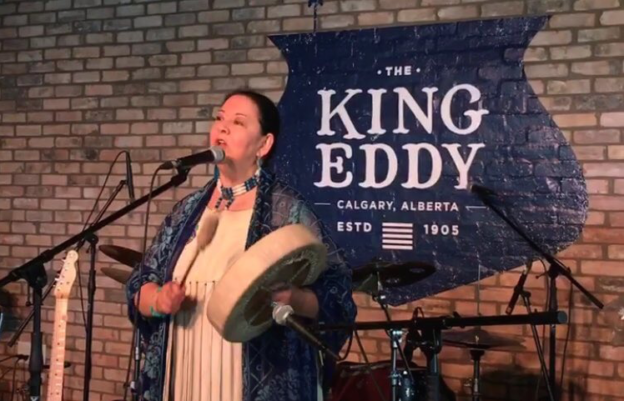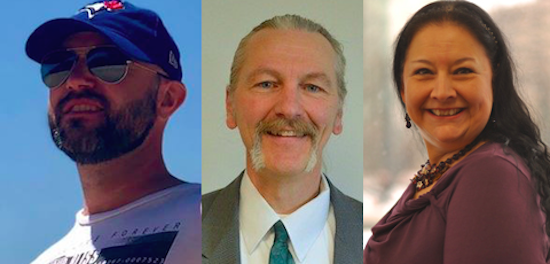Photo: New Green Party leader Cheryle Chagnon-Greyeyes at Canada Day celebrations in 2018 (photo source: @KingEddyYYC on Twitter)
Members of the Green Party of Alberta chose Cheryle Chagnon-Greyeyes as their new leader at a leadership selection meeting yesterday.
Chagnon-Greyeyes is an Indigenous social justice activist who currently works at the Native Centre at the University of Calgary. She is a member of the Muskeg Lake Cree Nation in Treaty 6 in Saskatchewan and is the first Indigenous woman to lead a political party in Alberta.
She defeated past leadership candidate Brian Deheer, a resident of Lac La Biche and chairperson of the Athabasca Watershed Council, and past election candidate Matt Levicki, a resident of Lamont with a background in media and broadcasting.
Former leader Romy Tittel resigned in early 2018.
During the leadership selection process, the three candidates were asked a series of questions and their answers were posted on the Green Party website. Here are some of Chagnon-Greyeyes’ answers:
Chagnon-Greyeyes: The GPA can change the current discussion in this province and reframe the current focus on pipelines, profit and power. We can shift the focus to people, what they need to live a good life: clean water, a home, an education, enough to live on. Let’s get people out to vote, especially those who don’t vote. Why don’t they vote? They feel powerless: “What difference can one vote make?” We can empower those people and plant seeds of possibility in the minds of 25-50% of eligible voters who don’t go to the polls. This is an untapped resource, a possible groundswell of support! Let’s empower the people to unite to make this province a better place to live, with ‘enough’ for all Albertans: enough food, water, housing, health care, mental health support, government services and real help. Heck, we might even sway some NDs and UCPs!
Chagnon-Greyeyes: When we play or work outside – our well being is linked to biodiversity. Alberta’s biodiversity includes provincial parks, developed recreation areas, pristine wilderness, natural landscapes, conservation areas and biological diversity, including heritage appreciation and tourism.
But what if we can’t go outside – too smoky. How do we ensure environmental health and integrity, and protect Albertans’ health and safety, from natural phenomena, climate-related conditions and events? We adapt, responding quickly to natural disasters, to be ready for them, because their impact is so widespread and devastating.
Can we mitigate these risks? The Green Party of Alberta wants to introduce an Environmental Bill of Rights, and advocates for ethical resource development, creating new jobs without sacrificing our air, land, water, animals, birds, fish – biodiversity. Ethical resource development integrated with economic, environmental, social and cultural considerations, and the inclusiveness and recognition of Indigenous interests.
Chagnon-Greyeyes: The moratorium aims to slow down resource extraction, and thoughtfully envision a better future for Alberta based on sustainability, accountability, and responsibility for our environment. Decision-making in this province focuses on one steadfast belief: “We need pipelines to get our product to market”. This assumes that pipelines are the ONLY viable, affordable option to transport oil. Let’s challenge that myth!
Dr. Ian Gates is patenting a pipeline-free solution to getting Alberta’s oil reserves to market in a cheap, sustainable manner while reducing the environmental risk of oil transportation. Self-sealing bitumen pellets, with a liquid core and super-viscous skin, can float on water if spilled; the pellets can be safely collected and removed. They can be produced right at the wellhead, same energy used as to dilute bitumen for traditional shipping. “Pipelines are finite and go to finite spots. Railcars go to virtually every port on every coast.”
The Green Party ran candidates in 24 constituencies in the 2015 election and earned a total 7,321 votes across the province. According to a CBC report, party president Marco Reid has said the Greens hope to recruit 50 candidates to run in next year’s provincial election. The party has nominated two candidates as of today – Allie Tulick in Calgary-Glenmore and Thana Boonlert in Calgary-Mountain View.


